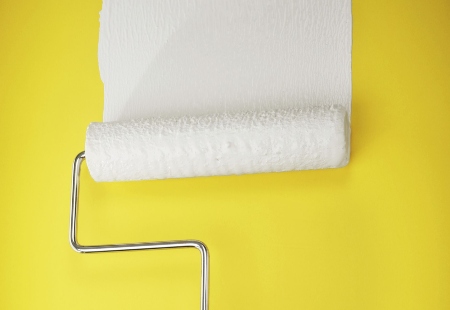Paint: It’s All About Chemistry

Although different types and grades of paint often exhibit different qualities as you apply them and after they are dry, all paints generally contain four ingredients.
- Pigments provide color and helps hide the surface underneath (prime pigments). Extender pigments increase the bulk of the mix without increasing the cost. For white paint, titanium dioxide (TiO2) is the most common prime pigment. It provides exceptional whiteness and hiding power and exhibits a greater tendency toward chalking in exterior paints. Organic color pigments include the brighter colors. Inorganic color pigments such as red iron oxide, brown oxide, ochers, and umbers, are not as bright as organic colors but are the most durable exterior pigments. Some commonly used extender pigments are clay, which provides hiding and stain resistance, silica and silicates, which increase scrub and abrasion resistance and control sheen, and zinc oxide, which increases resistance to mildew, corrosion, and staining.
- Binders hold the particles of pigment together and creates the integral film that adheres to a properly prepared surface. Oil-base binders can be organic oils such as linseed oil (squeezed from flax seed and refined), tung oil (from fruit of the chinawood tree), and soya oil (from soybeans), or modified oils called alkyds. Alkyds dry harder and faster than organic oils. Some coatings, chiefly exterior primers, combine oils and alkyds for increased flexibility. The term “oil-base” is commonly used to refer to both oil and alkyd coatings. The binder in latex-base paint is a plastic-like, milky-white liquid dispersed as microscopic particles in water. It is reminiscent of (but not related to) natural latex from the rubber tree. Pigment and binder are called the solids of the paint. They remain on the surface when the solvent evaporates.
- Solvents (also called the carrier or vehicle) make up the liquid constituent of the paint. The liquid carries the pigment and binder and makes it possible to flow them onto the surface being painted. As the liquid evaporates, the binders and pigments coalesce into a continuous protective film. Water is the solvent for latex paints. For most oil-base and alkyd paints, the solvent is a petroleum distillate. Shellac-base primers and varnishes use denatured alcohol as a solvent. Clear and pigmented lacquers use another petrochemical product, usually lacquer thinner.
- Additives are ingredients that bring specific properties to the paint, such as mildew resistance, reduced foaming, good flow, and even leveling. Thickeners control viscosity and how well the paint flows when applied. They reduce paint spattering when you use a roller to apply it. Surfactants stabilize the paint so it will not separate or become too thick to use. They also help wet the surface being painted so the paint won’t crawl (move about) when it is applied. Biocides keep bacteria from growing in the paint, and mildewcides discourage mildew from growing on the paint after it has been applied. Defoamers break bubbles as they are formed in the paint — especially important when rolling paint. Cosolvents are liquids additional to water that aid the binder in forming a good film, help the liquid paint resist damage if frozen, and enhance brushing properties, including flow and open time (the time the paint can be applied and worked before it sets). Cosolvents are generally volatile organic compounds (VOCs), which are increasingly subject to controls today.
Read the Label
The label tells the tale. Look at the label on the paint can carefully and you’ll find a wealth of information — some of which can affect your decision about whether to buy it or not. Labels will vary in content from manufacturer to manufacturer, but most provide advice on what surfaces the paint is designed for, how to prepare the surface, how to apply the paint, and an estimate of how much area the contents of the can will cover. Some labels will also provide supplementary information, such as thinning proportions for use in spray equipment. “Warnings” or “cautions” contain information about health and safety issues associated with use of the paint. Consult your Reno painting contractor if you have any doubts about which paints are best suited and safest for each painting project.
Watching Paint Dry
If you really could watch what happens as latex paint dries, you’d see the gradual formation of a tough film. In freshly applied paint, the particles of pigment and binder are dispersed widely in the liquid. The film starts to form when the water begins to evaporate. During this process, the particles of pigment and binder come closer together. As the last molecules of liquid evaporate, capillary action draws the binder particles together with great force, causing them to fuse with the pigment into a continuous film.
